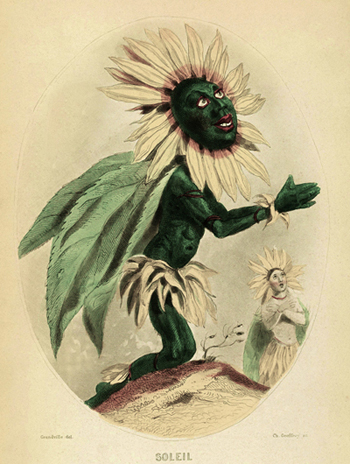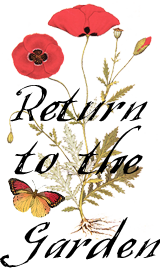| |
The sun is often employed magically to transform negative energy, and the sunflower is likewise utilized for the task of cleanisng and transformation. The sunflower itself is used to remove toxic chemicals from soil, including arsenic, lead and uranium. Sunflowers are so efficent at this that they have been planted near ponds in Chernobyl, where they extract caesium-137 and strontium-90. The sunflower, especially its bright petals, is used magically to remove jinxes and encourage positive outcomes.
Spiritualism, a religious sect that emphasizes communication with the dead, uses the sunflower as its emblem, saying "As the sunflower turns towards the sun, so spiritualism turns toward the light of truth." This idea that the head of the sunflower turns as the sun moves across the sky is a misnomer; once the flowerhead is mature it statically faces east, however it's young buds do shift throughout the day to maximize photosynthesis from the sun's rays.
|

FLOWER SORCERY

A Spell To Dream True
|
The lucid light of day is the sunflower's domain. When introduced to dreamwork, the sunflower greatly aids in lucid dreaming. It inspires prophetic dreams, and is especaially good revealing the truth about a situation. All this can be achieved by placing twelve sunflower petals in a circle around a single seed beneath your pillow at night.
|

To Celebrate The Summer Solstice |
Depending on the region you live in, harvest time for sunflowers may very, however midsummer harvests are common (around June 20th), therefore associating the sunflower with the midsummer sabbat (known also as Litha or Lithia). This celebration marks the high point of the sun's influence, and so also the dusk of its declining influence leading to the sacrifice of the Summer King (known in Faery Tradition by various names, such as Crom and Twr). The sunflower is one of the Summer Lord's emblems, and may be harvested for Litha and placed on an altar to ceremonially embody him. Address him with the following invocation.
|
Flower of Summer, King of Light
Behold the fullness of your might
From lofty throne must you secede
To be reborn again from seed
|
Celebrate now in honor of him. It is likely to be a bright, sunny day, so indulge in all the many glories he provides.
On the morning after summer solstice collect his seeds. Save these until the spring, then plant them to see the Flower of Summer rise again.
|
|
Please note: The spells contained on this page are not intended as a substitute for any legal, financial, psychiatric and or medical services.
|

SUNFLOWER FOLKLORE
|
Selections on Sunflower lore from "Folk-lore From Adam's County Illinois" by Harry H. Hyatt
#949: To have sunflowers growing in your backyard is good luck.
#5783 Sunflower seed in your shoes protects against rheumatism.
#6953: "Where sunflowers grow, the beaus don't go."
#8476: "To know the thief who robbed you: Take sunflower seeds which you must gather in the sign of the Lion in the month of August. Wrap them up over a wolf's tooth, then take a bay leaf and wrap the tooth, then take the tooth and put it above your head, and you will see the thief."
|
 |
Placing a dish of sunflower seeds upon a fresh grave will nourish the dead on his or her journey through the afterlife.
Adding sunflower leaves to a bath aids in cleansing away negative energy and illicits a more positive mood.
|
|
SUNFLOWER MYTHOLOGY
|
Greek mythology tells of Klytie, who in modern retellings is said to have turned into a sunflower after gazing obsessively at Helios (the sun) as he rode across the sky. The problem, however, if that the Greeks had no knowledge of Sunflowers, being that the helianthus hails from the Americas and were then unknown in the ancient Greek world. The confusion comes from the modern emphasis on the sunflower's trait of turning it's buds to follow the sun, however a similar trait occurs with the heliotrope (a genus of flowering plants in the borage family named after the sun god with whom Klytie was so enamoured), whose flowering clusters likewise turn towards the sun. Thus the heliotrope's name in middle english, turnsole, meaning 'to turn towards the sun.'
|

PROSE & POETRY
Golden rays of sun-filled days
Your gift to light the dark
Ideas of mind shall surely find
The strength to hit their mark.
- Storm Faerywolf
The heart that has truly loved never forgets,
But as truly loves on to the close;
As the sunflower turns on her god when he sets
The same look that she turned when he rose.
-Moore
Keep your face to the sunshine
and you cannot see the shadow.
It's what sunflowers do.
-Hellen Keller |

The Sunflower
Flower Of False Riches |
"The Sunflower has been thus named from the resemblance which its broad golden disk and rays bear to the sun. The first Spaniards who arrived in Peru were amazed at the profuse display of gold among the people, but they were still more astonished when, in May, they beheld whole fields covered with these flowers, which they concluded, at first sight, must be of the same precious metal. From this circumstance, and the observation that gold, however abundant, cannot render a person truly rich, the Sunflower has been made the emblem of false wealth. Many of the English poets have adopted the notion that this flower ever turns its face to the sun. Thomson, Moore, Darwin, and Barton make a very fine use of the idea. But it is not a fact. Those flowers which face the east at the opening of day, never turn to the west at the close of it." -Dumont
|

Above Image: "Soleil"
by J. J. Grandville 1867
|
Searcher of gold, whose days and nights
All waste away in anxious care.
Estranged from all of life's delights,
Unlearned in all that is most fair—
Who sailest not with easy glide,
But delvest in the depths of tide,
And strugglest in the foam;
O! come and view this land of graves,
Death's northern sea of frozen waves,
And mark thee out thy home.
-J.O. Rockwell
The Sun-flower does not derive its name, as some have supposed, from turning to the sun, but from the resemblance of the full-blown flower to the sun itself: Gerard remarks, that he has seen four of these flowers on the same stem, pointing to the four cardinal points. This flower is a native of Mexico and Peru, and looks as if it grew from their own gold. It flowers from June to October. -Hooper
And Sun-flowers planting, for their gilded show,
That scale the window's lattice ere they blow,
Then, sweet to habitants within the sheds.
Peep through diamond panes their golden heads.
-Clare
|
|
|
The common Sunflower is a native of Mexico and Peru, introduced into this country in the sixteenth century and now one of our most familiar garden plants. It is an annual herb, with a rough, hairy stem, 3 to 12 feet high, broad, coarselytoothed, rough leaves, 3 to 12 inches long, and circular heads of flowers, 3 to 6 inches wide in wild specimens and often a foot or more in cultivation. The flower-heads are composed of many small tubular flowers arranged compactly on a flattish disk: those in the outer row have long strap-shaped corollas, forming the rays of the composite flower.
The genus Helianthus, to which the Sunflower belongs, contains about fifty species, chiefly natives of North America; many are indigenous to the Rocky Mountains, others to tropical America, and a few species are found in Peru and Chile. They are tall, hardy, annual or perennial herbs, several of which are grown in gardens, being of easy cultivation in moderately good soil, and that useful plant of the kitchen garden, the Jerusalem Artichoke (Helianthus tuberosus), is also a member of the genus.
The name Helianthus, being derived from helios (the sun) and anthos (a flower), has the same meaning as the English name Sunflower, which it is popularly supposed has been given these flowers from a supposition that they follow the sun by day, always turning towards its direct rays. But since the word 'Sunflower' existed in English literature before the introduction of H. annuus, or at any rate before its general diffusion in English gardens, it is obvious that some other flower must have been intended. The Marigold (Calendulu officinalis) is considered by Dr. Prior to have been the plant described by Ovid as turning to the sun, likewise the solsaece of the Anglo-Saxon, a word equivalent to solsequium (sun-following). The better explanation for the application of the name to a flower is its resemblance to 'the radiant beams of the sun.'
In Peru, this flower was much reverenced by the Aztecs, and in their temples of the Sun, the priestesses were crowned with Sunflowers and carried them in their hands. The early Spanish conquerors found in these temples numerous representations of the Sunflower wrought in pure gold. In some of the old Herbals we find the Rock-rose (Helianthemum vulgare) also termed Sunflower, its flowers opening only in the sunshine. The so-called 'Pigmy sunflower' is Actinella grandiflora, a pretty perennial 6 to 9 inches high, from the Colorado mountains. -Grieve
|









